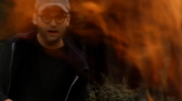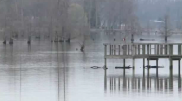'The Last Mountain' Documents The Fight To Save Appalachia From Coal
“The Last Mountain”, a documentary about mountaintop removal coal mining in West Virginia, made its west coast premiere at the Landmark Theater in West Los Angeles, Calif. on June 15. After a viewing of the film, Bobby Kennedy Jr. made an appearance to briefly engage the crowd in a Q-and-A discussion.
The film documents a crusade against coal energy by a variety of environmental activist groups in the Appalachian region near Coal River Mountain, W. Va. It also tells the legislative history of coal mining, such as the creation of the Clean Water Act of 1972, maneuvers by President George W. Bush’s administration and new policy currently in development.
Kennedy, an advocate for environmentalism through law and activism, joins the fight against coal mining.
“I saw something that, if the American people saw it, there’d be a revolution in this country,” Kennedy said in the film.
Kennedy travels to meet and interview people on all levels and sides of the coal mining debate. From high level executives, to residents of mining towns, to environmental activists, the film lets the people on the front lines tell their story and make a case for themselves.
'Practicing environmentalists’
In one of the film’s more heated moments, Kennedy meets with the president of the West Virginia Coal Association, Bill Raney.
Raney accuses activists of inaccurately portraying coal mining sites. Speaking of popular videos showing mining explosions and barren landscapes in the wake of coal extraction, Raney said activists are only concerned with inciting an “emotional impact.”
“It’s nothing more than a construction site that’s unfinished,” said Raney.
Raney calls his coal workers “practicing environmentalists” because of coal company’s forest reconstruction efforts.
The film takes the audience to see those “reconstructed” landscapes, which shows only grass where forests once stood and “stream substitutes” -- long piles of pebbles strewn down the sides of manufactured mountains -- where rivers once ran.
Beyond their environmental impact, those reconstructed forests do nothing to shield nearby towns from natural disasters. Once dense trees that blocked torrential rainfall from flooding adjacent towns are removed, there is nothing to absorb rainfall, turning seasonal rain into extensive flooding.
“This isn’t our fault, it’s an act of god,” one resident recalled a coal official saying.
The future of power
Although the film makes many appeals to the audience’s emotions through personal accounts, it also presents hard facts and figures that make a solid case for green energy.
Coal River Mountain Watch, a group portrayed in the film, raised money for a scientific wind survey of the mountainside they are trying to protect. It found that the area has excellent potential for wind power, an investment they say that would not only create new jobs but harness enough energy to provide for 70,000 homes’ needs.
To give some perspective, the film went on to interview a catholic boarding school in Rhode Island that also uses wind power. A representative said that the energy derived from its single windmill meets 40 percent of the campus’ energy needs. It operates in an area that produces category 2 winds.
According to the scientific survey, the Coal River Mountain region produces category 5 winds.
Maria Gunnoe worked with CRMW to produce the wind energy plan, which earned her the 2009 Goldman Environmental Prize. She says in the film:
"We live in a very intelligent country that has the ability to create energy without blowing up mountains,” she said.
The film goes on to give more stories from the region, such a new scientific study examining coal’s link to a perceptible increase of brain tumors and autism in areas near mines. It chronicles the fight to move an elementary school from a toxic coal silo, and the controversial legacy of Don Blankenship’s rise to become Massey Energy’s CEO.
The fight for the protection of Coal River Mountain remains unresolved at the end of the film. However, environmentalists had experienced some victory with the closure of some mines and the implementation of stricter regulations.
TRAILER
A candid Bobby Kennedy, Jr.
After the documentary showing, Kennedy addressed the crowd in Los Angeles to give more context on his fight against non-renewable energy sources.
Kennedy was quick to encourage the crowd to promote the work profiled in the film because, he said, the way coal companies are “keeping people uninformed and subverting the rights of people around it.”
He said that mainstream news media is not doing enough to inform the public on these issues and it’s up to a new generation of journalists to step up to the bat.
“We are the best entertained, least informed people on the face of the Earth,” he said.
Along with other recent environmental films -- such as Gasland and An Inconvenient Truth -- he said more people can become familiar with crucial energy topics that go under-reported.
“Documentary filmmaking serves a critical role in the function of democracy,” he said. “It’s one of the only ways to inform the public at this time.”
Kennedy moved on to answer a few questions from the audience, including his thoughts on Blankenship’s recent stepping down.
“It’s a faux transfer,” he said. “It’s a way of getting government agencies off Massey, but the company is going to continue doing the same stuff.”
However, he was confident that, over time, clean energy will prevail because of a move toward socially responsible capitalism.
“We are going to win through market forces -- eventually,” he said. “Clean energy does what a good market does -- reward the good, which is efficiency, and punish the bad, which is inefficiency.”
The road ahead
The fight continues for the protection of not only Coal Mountain, but of all of Appalachia. Climate Ground Zero, a nonviolent resistance protest group also featured in the film, continues to fight against mountaintop removal mining. On June 14, more than 1,000 activists organized by CGZ marched against mining at Blair Mountain.
To get involved, CRMW’s website provides direct links to government petitions on coal mining. You can support CGZ’s civil disobedience by donating or joining in the fight.






